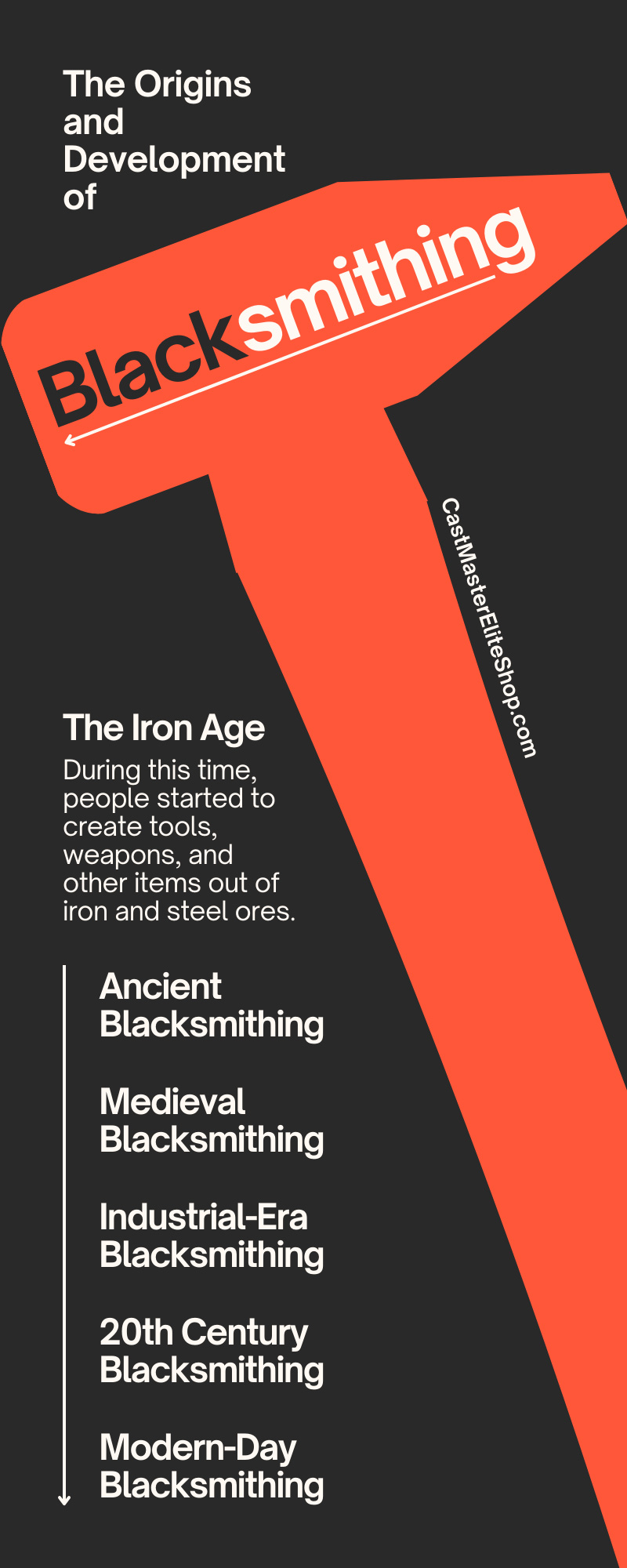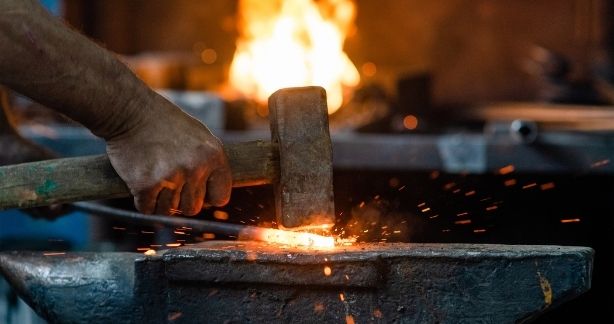You might think that blacksmithing is a long-forgotten art, left behind in the Medieval days. However, the art of blacksmithing is currently experiencing a modern resurgence and has many modern-day applications. Modern blacksmithing creates a plethora of assorted products, from jewelry to weapons, and has a tight-knit community. But how did we get here? Historians can trace smithing practices back thousands of years and the craft has come a long way. To give you an idea, here is a deep dive into the origins and development of blacksmithing over the centuries.
Blacksmithing Origins
Blacksmithing was set up by craftsmen of the early Stone Age when they created weapons and tools out of stone and various weak ores. Metals like gold, silver, and copper that they would have discovered first are all very malleable, meaning they were very pliable. Early human hammering techniques would have been enough to shape them. It wasn’t until the Bronze Age that humans learned to smelt and melt ores such as copper and bronze. Bronze was clearly the superior choice of ore for its strength and the fact that it is very corrosion-resistant. In fact, many early bronze artifacts have survived thousands of years.
The Iron Age
Following the Stone Age and the Bronze Age came the Iron Age in the year 1200 B.C. The Iron Age is aptly named for the period that humans discovered iron ore. During this time, people started to create tools, weapons, and other items out of iron and steel ores. While they may have considered iron to be inferior to bronze, they quickly started to favor iron when discovering that they could create steel from heating iron and carbon. It’s interesting to note that many historians credit the Hittites, a group of Indo-Europeans, for discovering this creation as far back as 1500 B.C., long before the Iron Age.
Ancient Blacksmithing
With the discovery of iron and steel, ancient blacksmiths could create weapons and tools that were far stronger than stone or bronze ones. During this period, charcoal was the fuel of choice for many early blacksmiths. However, back in these ages, smiths didn’t have a full grasp on the properties of iron ore, and their work was very inconsistent due to this lack of knowledge. On the other hand, when they were successful in using steel, these weapons and creations were notably stronger and regarded highly, almost with an air of mysticism.
Medieval Blacksmithing
When many folks hear the word “blacksmith,” odds are that an image of a Medieval-era blacksmith pops into their head. This is due to the common portrayal of Medieval Blacksmiths in fantasy books, games, movies, and even real-life events, such as Renaissance Fairs. However, there is much more to this type of smithing than they portray.
Blacksmiths were such a common necessity during these times that they were considered a staple of every town or village. These “village smithies” crafted a variety of items for their communities, including weapons and armor like they are known for. But they also crafted everyday items like nails, horseshoes, locks, tools, and other household items. The forging fuel of choice during this era was also charcoal. Blacksmiths during this period also developed a technique of hammering and forging materials for long periods of time to strengthen it—much longer than many blacksmiths practice today.
On the darker side of things, the techniques that skilled blacksmiths used were so advanced that some started to be labelled as witches harnessing magic and practicing witchcraft.
Industrial-Era Blacksmithing
Blacksmithing started to see a decline in popularity and status during the Industrial Era, when automation became the norm. Humans were able to develop machines that could take the design of armor and tools and create identical copies. This method was also cheaper, which further eliminated the need for smiths. However, blacksmiths didn’t disappear altogether. In fact, farriers (also known as those who shoe horses) were still in demand, as machines weren’t able to recreate the delicate design of horseshoes for each individual horse. Those who didn’t go on to be farriers may have transitioned into machining work or applied their skills as automobile mechanics.
20th Century Blacksmithing
Blacksmithing had a short boon in the 20th century, where smiths would create custom wrought-iron pieces and architectural ironwork. However, it didn’t last long when the Great Depression hit and rendered the craft nearly extinct. If industrialization pushed blacksmithing into its decline, then the Great Depression tanked it. Because machines and automation were so prevalent, blacksmithing wasn’t needed and was deemed obsolete by many—until its recent resurgence, that is.
Modern-Day Blacksmithing
The resurgence of blacksmithing started around the 1970s, when people started to once again appreciate the care that went into the craft. After being on the road to recovery from the Great Depression, the world had the resources and funds to invest back into crafts such as blacksmithing. Although they no longer fit the Medieval reputation of being an absolute necessity to the community, blacksmiths were praised for their handiwork and skill in terms of an art form. Modern blacksmiths use a variety of fuels beyond simply charcoal (although many smiths do still use this fuel source). They also have a full knowledge of metals and techniques at their disposal.
This brings us to modern-day blacksmithing, which we at Cast Master Elite are extremely passionate about. Blacksmithing has once again become a viable career option for many, while others choose it as a pastime and hobby. Whatever your reason for being interested in the craft, you can shop with us for all your metal forging equipment needs, including everything from tools and accessories to forge kits.
We hope this look into the origins and development of blacksmithing was able to shed some light on the blacksmithing practices of the past and how the craft has become what it is today. Blacksmithing has had its ups and downs throughout history, but we value it more today because of them. Now, when you picture a blacksmith in your head, you can think of a modern iteration just as much as a Medieval one.







